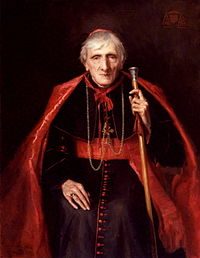Cardinals created by Leo XIII
Pope Leo XIII (r. 1878–1903) created 147 cardinals in 27 consistories held at roughly annual intervals.
Another of Leo's cardinals, von Fürstenberg, had a cousin in the College appointed in 1842 by Pope Gregory XVI.
Pope Leo's appointments also included the first Australian,[6] Moran, the first Canadian,[7] Taschereau, the first Slovenian,[8] Missia, and the first Armenian,[9] Hassoun, who was also the first prelate of an Oriental rite made a cardinal since 1439.
[10] Cardinals who died before visiting Rome to be assigned their titular churches included Guilbert, Lluch, and Rotelli.
[14] On 22 September he gave red galeri to three of them (Desprez, Haynald, and Pie), as well as to János Simor, whom Pope Pius IX had made a cardinal in 1873.
[10] Ricci Paracciani's cousin Salvatore Nobili Vitelleschi was made a cardinal in 1875, just five months before he died.
[34] Rotelli received his red hat from French President Sadi Carnot,[35] but died before being invested by the pope with the other symbols of his new rank.
[39] Francesco Satolli, Apostolic Delegate to the United States, did not travel to Rome for the ceremony, but received his insignia of office from Cardinal James Gibbons, Archbishop of Baltimore,[44] on 5 January 1896.
[49] Pope Leo announced the creation of 11 new cardinals on 19 June 1899[50] and created two in pectore, Alessandro Sanminiatelli Zabarella and Francesco Salesio Della Volpe, whose names were published in 1901.
Only Nocella, Cavicchioni, and Fischer were present to receive their red hats from the pope and be assigned their titular sees on 25 June.
[53][54] The others participated in the conclave that elected Pope Pius X and it was from him that Herrero received his red galero and titular church assignment on 27 August,[55] as did Aiuti, Taliani, and Karschthaler theirs on 12 November 1903.

















